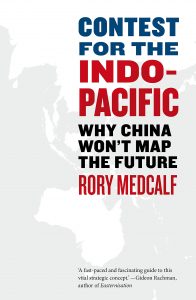
The Indo-Pacific region has turned into one of the most critical regions in the 21st century, affecting the entire world’s power dynamics. As the nations in the region are home to over a third of the world’s total population, they also share deep-rooted cultures, trade, and connections. As the Indo-Pacific region becomes the centre stage for global strategic and commercial interests, the time has come for the region to rebalance itself to face a new kind of strategic competition through both co-operation and confrontation; which may impact the social, political, economic, and the geographic overtures in this region. The book ‘The contest for the Indo-Pacific: Why China won’t map the future’ written by Professor Rory Medcalf tries to make sense of the Indo-Pacific by looking into its past, present, and future and tries to explain ways through which this region can cope up with the rise of China’s assertive power.
Professor Rory Medcalf heads the National Security College at the Australian National University. He has had over three decades of experience working as a diplomat, Intelligence analyst, and researcher. He also has been recognised as a thought leader internationally for his work on the Indo-Pacific concept.
The author has divided his book into three parts through which he sets the groundwork for his hypothesis. In the first three chapters of this book, Professor Medcalf examines the historical connections that the kingdoms and countries shared through various means, including culture and commerce. The author assimilates the Indo-Pacific region’s shared historical overtures and sheds new light on various powers, significance, and actions. Contrary to the Chinese historical claims of a robust connection with the Indian Ocean region, Professor Medcalf cleverly busts out the myths often shared by the Chinese premiers regarding historical linkages. As a matter of fact, the author argues that the Chinese seaborne activities started in the 11th century BCE and ceased their sea-going activities by the start of the 17th century.
The following chapter in the ‘past’ section looks into the developments within the countries in the Indo-Pacific post World War II. Professor Medcalf notes an early classified British foreign policy report titled ‘The Indo-Pacific Strategy’, which was drafted to secure their interests in the region. Professor Medcalf aptly explores the Australian identity crisis that they had to face in the region for a long period of time, and also he looks onto the Singaporean touch for the inclusion of India as a player to balance the power with China. The author argues that the Chinese push for Asia-Pacific in regional forums was less Asia-pacific and more global forum-making. Finally, Professor Medcalf concludes the context by elaborating about the significant shift in China’s foreign policy and strategic outlook from 2008. The author argues that from Hu Jintao to Xi Jing Ping, the Chinese foreign policy saw a massive shift from disengagement to passive aggression in the South China Sea to the Indian Ocean Region. The author identified the stakes that the countries have in this region and the notable shifts in their policies, leading to a well thought out chapter providing profound insights into the policy transformations. In short, this chapter provides some exciting takeaways that can be summarised by an exciting quote by Professor Medcalf that “The idea of merging Asia and the Pacific Ocean as one coherent piece of the world may seem natural now. Googling’ Asia-Pacific’ brings up hundreds of millions of results, drowning the mere tens of millions from an ‘Indo-Pacific’ search. After all, the Asia-Pacific was the received wisdom at the start of the internet age. On the other hand, the Indo-Pacific turns out to be a more enduring idea”.
In the next section of the book, Professor Medcalf talks about the present situation in the Indo-pacific region. The convergences and divergences in regards to the latest power competition between players in the region were argued in the subsequent chapters. The author examines the roles of giants such as India, the US, China, Japan, and Australia as significant powers whose actions shall have an impact on the future course of this region. The author talks about the geopolitical positioning players in South East Asia, such as Indonesia, Vietnam, Cambodia. Professor Medcalf also discusses the Chinese engagements concerning Pakistan, Iran, and the Middle East; talks about the base race in which several global players are engaged to secure their commercial and security interests. While Professor Medcalf observes the Russian interests in the Indo-Pacific region, the author also looks at how the latest power competition has spilled over to the African continent.
In his final chapter, Professor Medcalf looks into prospects of the Indo-Pacific region. He examines several future scenarios wherein hostilities remain, the Indo-Pacific region regarding several disputes with Taiwan, clashes in the SCS, India, and addresses a critical, open-ended question regarding the ownership of Antarctica as well. The author argues for a careful co-existence between China and other countries in the region through co-operation, flexibility, and mutual trust. Professor Medcalf shares several valuable recommendations for the future in order to increase prosperity, inclusiveness, and understanding to ensure lasting peace in the region.
Finally, this book is perfect for newcomers as well as researchers who wish to broaden their knowledge of the Indo-pacific region. The book connects the past with the present very well and is written very comprehensibly. The book has a very engaging tone throughout its chapters which shall keep the readers well satisfied with the contents of the book. The book is an excellent source to learn the various facets regarding the Indo-Pacific region and also acknowledge that the ‘Indo-Pacific’ has more to offer than a mere term in this modern world.













